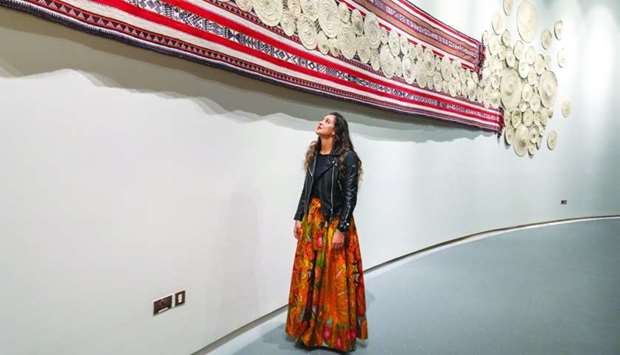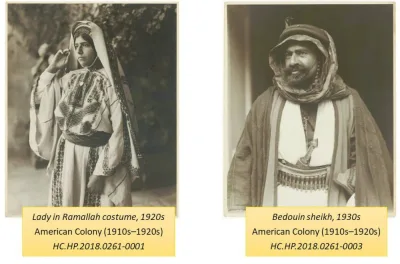Asma Derouiche smiles as she gestures at a 13-by-3-metre artwork hanging in front of her.
“This country was wrought by people who lived on the land, and by people who lived off the sea,” says the Virginia Commonwealth University School of the Arts on Qatar (VCUarts Qatar) MFA in Design alumna, as she explains the concept behind ‘Synergy’, an exhibition organised and curated by Derouiche and Tariq al-Jaidah, who founded the Eiwan gallery in Al Gassar Resort – where the display is on show until January 23 – with the vision of developing the art production landscape in Qatar.




“For that reason, when we had the idea to conduct an exhibition for Qatar’s National Day, we wanted it to reflect that synergy; that deep-rooted circular connection between people who lived in a bygone era, and those who live here now – their lives and livelihoods intertwined by the sea and the land.”
The collection is a revitalised interpretation of Qatar’s heritage. Derouiche and al-Jaidah formed a collective with the aim of collaborating with local talent, and invited Qatar-based artists Ahmed al-Bahrani, Ahmed al-Maadheed, Azzam al-Mannai and Fatima al-Shaiban, and local craft masters Umm Atiq al-Marri and Mohamed al-Balkoum to contribute bespoke artwork to the exhibition – all in under two months.
As Derouiche – designer and creative director, House of Arts – describes the concept and creative processes behind 'Synergy', one thing becomes clear: the exhibition emerged from the singular desire of a group of young artists and designers to showcase their respect and admiration for the country they call home.
It is an emotion that is palpable to a visitor entering the gallery; almost immediately, one’s attention is drawn to two large hand-woven wall-hangings made using 'sadu', a weaving technique traditionally associated with the region, and 'sofra', the craft of plaiting palm leaves.
Further down are decorative leather hangings depicting symbols. Aerial photographs juxtaposing human activities against the stark emptiness of the desert, sculptures that portray Qatar’s increasing global presence, poetry cast in concrete, and canvases that harken back to a simpler lifestyle, make up the rest of the display.
“In order to respect and learn from another culture, you first must make the effort to understand it,” says the Tunisian-born designer. “I feel it’s exciting when people from abroad – expats like myself – explore the resources available locally, and use their individual interpretation to create something beautiful from it. In a way, it’s our way of contributing to Qatar.
“On a personal level, I have spent the last three years exploring the art and design landscape here, working with local artists and craftsmen in souqs to first appreciate the rich artistic heritage of the country, and then to collaborate with them, often giving traditional designs a contemporary twist.”
Derouiche also notes how the exhibition mirrors Qatar’s identity – one that boldly balances the contemporary with the classic.
“Over the years, Qatar’s persona has evolved into a cosmopolitan, heterogenous one, and the creativity you see here is an embodiment of that spirit,” she explains. “For instance, my motive in creating the large wall-hanging titled ‘My tribe is Qatar’ was multi-fold. I wanted to capture those symbols and patterns traditionally used by various tribes in 'sadu' weaving, to create one seamless artwork that showed how, irrespective of where we come from, we all belong to Qatar.
“Additionally, I also felt it was time for our generation to re-envision the manner in which traditional and locally-produced elements could be used to give expression to what Qatar has grown into. That’s why I chose the unusual combination of 'sadu' and 'sofra'; the rigid linearity of 'sadu' is offset by the pliable adaptability of 'sofra'. And that’s also why the 'sofra' appear to flow out of the 'sadu' in a burst of bubbles; it shows the energy and dynamism of this country.”
References to the country’s history can also be seen in the mustard-hued wall-hangings made of camel leather; laser-engraved patterns– inspired by the symbols used by Qatari tribes to brand their herds of sheep, camels or goats to prevent them from getting lost or stolen – start out at one end of the hide, and then blend into a single pattern on the other, signifying Qatar’s journey from a cluster of tribes to the unified country that it is today.
Derouiche has another piece of interesting information to share; when quizzed on the materials used to fashion the artwork, her eyes light up.
“Almost all the materials used in the exhibition are sourced from Qatar,” she says. “But if you really want to know the exact sources, the leaves used to fashion the 'haseer' on one of the wall-hangings were taken from the date palm in front of my apartment in The Pearl. You can’t get more local – or sustainable – than that!”




“For that reason, when we had the idea to conduct an exhibition for Qatar’s National Day, we wanted it to reflect that synergy; that deep-rooted circular connection between people who lived in a bygone era, and those who live here now – their lives and livelihoods intertwined by the sea and the land.”
The collection is a revitalised interpretation of Qatar’s heritage. Derouiche and al-Jaidah formed a collective with the aim of collaborating with local talent, and invited Qatar-based artists Ahmed al-Bahrani, Ahmed al-Maadheed, Azzam al-Mannai and Fatima al-Shaiban, and local craft masters Umm Atiq al-Marri and Mohamed al-Balkoum to contribute bespoke artwork to the exhibition – all in under two months.
As Derouiche – designer and creative director, House of Arts – describes the concept and creative processes behind 'Synergy', one thing becomes clear: the exhibition emerged from the singular desire of a group of young artists and designers to showcase their respect and admiration for the country they call home.
It is an emotion that is palpable to a visitor entering the gallery; almost immediately, one’s attention is drawn to two large hand-woven wall-hangings made using 'sadu', a weaving technique traditionally associated with the region, and 'sofra', the craft of plaiting palm leaves.
Further down are decorative leather hangings depicting symbols. Aerial photographs juxtaposing human activities against the stark emptiness of the desert, sculptures that portray Qatar’s increasing global presence, poetry cast in concrete, and canvases that harken back to a simpler lifestyle, make up the rest of the display.
“In order to respect and learn from another culture, you first must make the effort to understand it,” says the Tunisian-born designer. “I feel it’s exciting when people from abroad – expats like myself – explore the resources available locally, and use their individual interpretation to create something beautiful from it. In a way, it’s our way of contributing to Qatar.
“On a personal level, I have spent the last three years exploring the art and design landscape here, working with local artists and craftsmen in souqs to first appreciate the rich artistic heritage of the country, and then to collaborate with them, often giving traditional designs a contemporary twist.”
Derouiche also notes how the exhibition mirrors Qatar’s identity – one that boldly balances the contemporary with the classic.
“Over the years, Qatar’s persona has evolved into a cosmopolitan, heterogenous one, and the creativity you see here is an embodiment of that spirit,” she explains. “For instance, my motive in creating the large wall-hanging titled ‘My tribe is Qatar’ was multi-fold. I wanted to capture those symbols and patterns traditionally used by various tribes in 'sadu' weaving, to create one seamless artwork that showed how, irrespective of where we come from, we all belong to Qatar.
“Additionally, I also felt it was time for our generation to re-envision the manner in which traditional and locally-produced elements could be used to give expression to what Qatar has grown into. That’s why I chose the unusual combination of 'sadu' and 'sofra'; the rigid linearity of 'sadu' is offset by the pliable adaptability of 'sofra'. And that’s also why the 'sofra' appear to flow out of the 'sadu' in a burst of bubbles; it shows the energy and dynamism of this country.”
References to the country’s history can also be seen in the mustard-hued wall-hangings made of camel leather; laser-engraved patterns– inspired by the symbols used by Qatari tribes to brand their herds of sheep, camels or goats to prevent them from getting lost or stolen – start out at one end of the hide, and then blend into a single pattern on the other, signifying Qatar’s journey from a cluster of tribes to the unified country that it is today.
Derouiche has another piece of interesting information to share; when quizzed on the materials used to fashion the artwork, her eyes light up.
“Almost all the materials used in the exhibition are sourced from Qatar,” she says. “But if you really want to know the exact sources, the leaves used to fashion the 'haseer' on one of the wall-hangings were taken from the date palm in front of my apartment in The Pearl. You can’t get more local – or sustainable – than that!”



